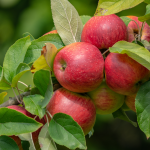Benefits & Uses of Fall’s Produce Powerhouses
Welcome to the Fall Edition of the Seasonal Eating Guide, from your year-round farmers market!
This segment of the Fall Guide lists Fall favorites, their nutritional benefits, harvest time, and the different ways they can be used.
For more insights and tips on seasonal eating, be sure to check out the Fall Guide’s other segments:
- How to Get Your Healthy On – for You & the Ecosystem takes a closer look at how eating seasonally puts your body in sync with what Mother Nature provides, season by season.
- If It Grows Together, It Goes Together draws on ancient wisdom to help you make the most of eating seasonally this Fall.
- It’s Soup Season! goes on a deep dive into Fall’s number one comfort food, complete with recipes, including bone broth.
- Farmer Spotlight introduces you to the young Amish family of Spring Creek Meadows, who rely on manpower, horses, and regenerative farming practices to raise their livestock.
Fall Food Faves
Find out why the season’s favorite foods are so good for you and some of the ways you can enjoy their nutritional benefits.
BENEFITS: Heart-healthy flavonoids in the skin, antioxidants, and 4 grams of dietary fiber.
USES: Eat raw as a stand-alone snack, in a smoothie or salad, in pork dishes, or cooked up as applesauce or pie.
HARVEST: August-November
BEETS
BENEFITS: Red and gold beets are nutritional champs known for their high concentration of nitrates and accompanying blood pressure-lowering effects. They are also high in fiber and packed with nutrients.
USES: Beets are best enjoyed cooked, and then can be used in salads, as a side, or even in a colorful dip.
HARVEST: Year-round
BROCCOLI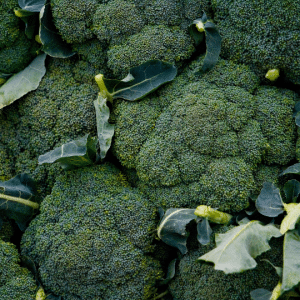
BENEFITS: One cup of broccoli has as much vitamin C as an orange. Sulforaphane and other natural compounds in broccoli are reported to stop cancer cells from forming in your body.
USES: Enjoy broccoli raw, in a salad, with a dip, or mixed into a fantastic stir fry.
HARVEST: September-November
BRUSSELS SPROUTS
BENEFITS: Brussels sprouts are high in fiber, vitamin K, vitamin C, plus folate and iron.
USES: Serve as a side or atop salads and meats, steam or roast, serve with salt or add tangy or savory sauces like balsamic vinegar.
HARVEST: September-March
CARROTS
BENEFITS: Loose carrots are a particularly good source of beta carotene, fiber, vitamin K1, potassium, and antioxidants.
USES: Raw with dips or in salad, roasted as a side, or that perennial favorite — carrot cake!
HARVEST: September–November
CAULIFLOWER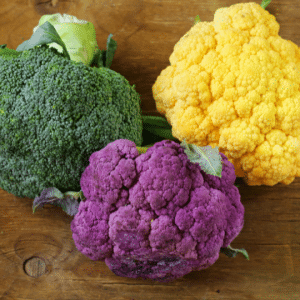
BENEFITS: Vitamin C and compounds that may help to prevent cancer and lower cholesterol.
USES: Raw with dips or in salad, steamed or roasted as a side, blended like mashed potatoes or pureed into soup.
HARVEST: September–June
CELERY ROOT (a.k.a. Celeriac)
BENEFITS: High in fiber and a good source of vitamins B6, C, K and minerals phosphorus, potassium, and manganese.
USES: Raw or cooked, celery root is a versatile vegetable. It can be used as a base for salads, stews and soups, and also works well mashed, baked, roasted or boiled.
HARVEST: September–November
CELERY
BENEFITS: Packed with antioxidants, vitamin C, beta carotene, and flavonoids, and a great source of phytonutrients which have been shown to reduce inflammation.
USES: Celery is great raw, and you can eat the leaves too! It’s a classic base ingredient in soups and stews, or try it steamed or baked for a twist on this good old reliable veg.
HARVEST: October-December
DARK LEAFY GREENS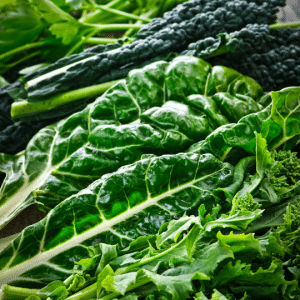
BENEFITS: Iron, calcium, vitamins A and C, and fiber.
USES: Raw in a salad or smoothies, or baked into other dishes. Cooking makes it easier for our bodies to digest its nutrients.
HARVEST: Year-round
FENNEL
BENEFITS: Vitamin C, potassium.
USES: Looks like the love child of a dill plant and an onion but has a mild licorice flavor – add to soups, sides, and mains.
HARVEST: Fall through spring
PARSNIPS
BENEFITS: Potassium, fiber.
USES: Sweeter and nuttier than carrots, roast alone or with just about every other fall vegetable.
HARVEST: October-April
PEARS
BENEFITS: Vitamin C, copper, 4 grams of fiber.
USES: Enjoy raw alone or with cheese, in salads, and baked or poached desserts.
HARVEST: August-February
PUMPKINS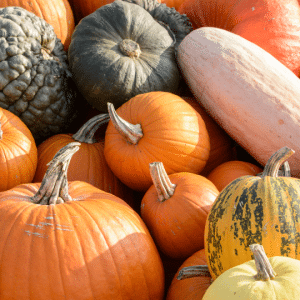
BENEFITS: Potassium, tons of fiber, B vitamins.
USES: Pies, soups, and sides, plus toss seeds in olive oil and salt, then roast for an addictive snack or salad topping. Also jack o’lanterns!
HARVEST: October-February
RUTABAGAS
BENEFITS: Vitamin C, fiber.
USES: Like a cross between a turnip and a parsnip, they’re delish in casseroles, pureed with turnips and carrots for soup, or roasted with ginger, honey, or lemon.
HARVEST: October-April
SPINACH
BENEFITS: Vitamins A, C, K, iron, and disease-fighting phytonutrients.
USES: Raw in a salad or smoothies, steamed as a stand-alone or baked into other dishes. Cooking makes it easier for our bodies to digest its nutrients.
HARVEST: Year-round, but it gets sweeter after the first nip from Jack Frost
SWEET POTATOES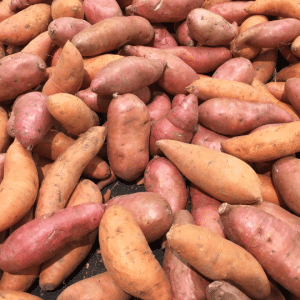
BENEFITS: Vitamin A, iron, and anti-inflammatory properties.
USES: Roast like a potato or cut up like fries, add to salads and stews, puree into soups.
HARVEST: September–December
TURNIPS
BENEFITS: Vitamin C (roots), vitamins A, K, and folate (leaves).
USES: Steam, roast, or boil the roots, flavor with fennel, bread crumbs, or brown sugar. Adds a slightly bitter complement to sweet parsnips, carrots, or mashed potatoes. Steam or stir fry the leaves.
HARVEST: September–April
WINTER SQUASHES
BENEFITS: Omega-3 fatty acids, vitamin A.
USES: Butternut and acorn have thick skin and can be stored for months. Bake, steam, or roast plain or with cinnamon and ginger, add to salads and stews, puree into soups.
HARVEST: October–February
About Seasonal Roots
Since 2011, Seasonal Roots’ online farmers market has connected Virginia families with local family farmers who use sustainable, humane practices. Our neighborhood market managers – who believe in living better through scrumptious, healthy eating, being kind to animals, protecting the environment, and spreading joy – home-deliver freshly harvested produce, pastured eggs, grass fed dairy and meat, plus artisan fare. We empower our members to eat better and live better with more nutritious, flavorful food that’s good for us and good for the planet. More info at seasonalroots.com.
